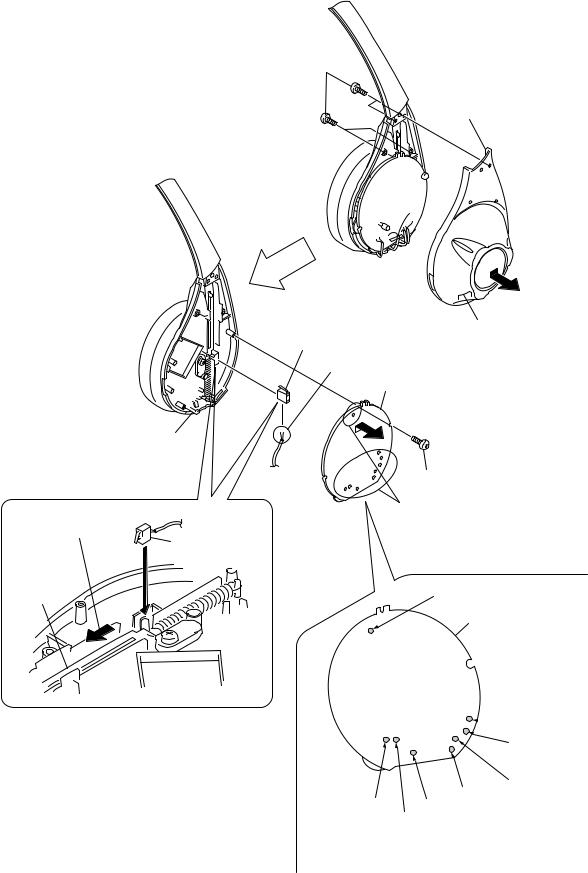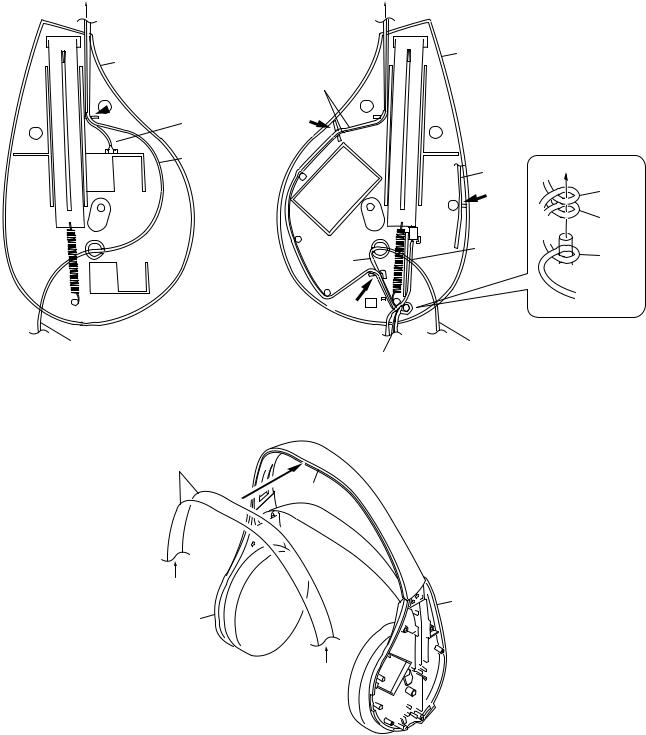Sony MDRRF-815-R Service manual

MDR-RF815R
SERVICE MANUAL |
AEP Model |
Ver 1.2 2001. 11 |
UK Model |
|
MDR-RF815R is the component model block one in the MDR-RF815RK.
COMPONENT MODEL NAME FOR MDR-RF815RK
Headphones |
MDR-RF815R |
|
|
Transmitter |
TMR-RF815R |
|
|
|
SPECIFICATIONS |
Headphones |
|
Power source |
DC 2.4 V: Built-in rechargeable |
|
battery |
Mass |
Approx. 240 g (8.1 oz.) incl. |
|
built-in rechargeable battery |
Built-in Ni-Cd rechargeable battery |
|
Model name |
NC-AA |
Voltage |
1.2 V |
Capacity |
700 mAh |
Design and specifications are subject to change without notice.
HEADPHONES
9-927-956-12 Sony Corporation
2001K1600-1 Personal Audio Company
© 2001.11 |
Published by Sony Engineering Corporation |

SECTION 1 GENERAL
This section is extracted from instruction manual.
5-B Turn up the volume to a moderate level with the VOL control, then tune the headphones in to the frequency of the transmitter with the TUNING control until you can hear the audio signal loud and clear.
B MDR-RF815R
Auto power on/off function
When you remove the headphones from your head, the power turns off automatically. Do not allow the self adjusting band to be pulled up, otherwise the headphones will be switched on.
The power turns on.
TUNING control
 VOL control
VOL control
SAFETY CHECK-OUT
After correcting the original service problem, perform the following
safety checks before releasing the set to the customer.
1.Check the area of your repair for unsoldered or poorly-soldered connections. Check the entire board surface for solder splashes and bridges.
2.Check the interboard wiring to ensure that no wires are "pinched" or contact high-wattage resistors.
3.Look for unauthorized replacement parts, particularly transistors, that were installed during a previous repair. Point them out to the customer and recommend their replacement.
4.Look for parts which, through functioning, show obvious signs of deterioration. Point them out to the customer and recommend their replacement.
5.Check the B+ voltage to see it is at the values specified.
6.Flexible Circuit Board Repairing
•Keep the temperature of the soldering iron around 270˚C during repairing.
•Do not touch the soldering iron on the same conductor of the circuit board (within 3 times).
•Be careful not to apply force on the conductor when soldering
— 2 —

SECTION 2
DISASSEMBLY
Note : Follow the disassembly procedure in the numerical order given.
2-1. RX-BASE BOARD
1 Four screws (P 2 × 6)
Cover (R), hanger
 7
7
Claw
Precaution for installtion
1Slide the suspender in the direction of the arrow.
2 Set the psuh switch (1 key).
Suspender
2
Claw
9 Switch, push (1 key)
8 Remove the two solderings.
6 RX-BASE board
5
4 Screw (P 2 × 8)
3Remove the nine solderings.
Precaution for installtion
No.205
RX-BASE board

 No.204
No.204
 No.201
No.201
No.201 (green)
No.202
No.202 (red)
No.203 No.204
No.203 (black)
Solder the each lead wires directly to the position as shown while being cautions of colors.
— 3 —

Set the lead wires
Set the each lead wires as illustrated below.
B A
Cover (L), hanger
 Groove
Groove
No.203
No.201
To the driver (030F032//K).
No.201, No.203
No.201, No.203
Groove
Groove 
Groove 
No.202
Groove
To the RX-BASE board
Groove
B
Cover (L), hanger
A
Cover (R), hanger
No.205 |
|
Groove |
No.201 |
|
No.203 |
No.204
No.202
To the driver (030F032//K).
Cover (R), hanger
— 4 —
SECTION 3
ELECTRICAL ADJUSTMENTS
Ver 1.2 2001. 11
Notes:
1.Use transmitter with check and adjustment already completed.
2.On adjusting the headphones section, use the transmitter as a jig.
Headphones:MDR-RF815R Transmitter:TMR-RF815R
Procedure:
1.Connect an oscillator with attenuator and terminator (600 Ω) to the transmitter AUDIO IN-A connector (J402).
2.Connect an AC adapter to the transmitter DC IN 9V jack (J404).
3.Connect lead wires to IC301 pin 4, pin 6, pin 7 and GND on the RX-BASE board.
4.Connect a resistor 33k Ω between IC301 pin 4 and pin 7.
5.Connect lead wires to the speakers’ terminals (L+,L-,R+,R-) on the RX-BASE board.
3-1. Free run frequency check and adjustment
1.Set the transmitter AUDIO IN-A connector (J402) to no signal. Note: In this case, operation time is about 4 or 5 minutes.
2.Check the transmitter power indicator (red) lights.
3.Set the transmitter CHANNEL switch to 1.
4.Set the head phones tuning (RV303) to center position.
5.Connect a frequency counter to IC301 pin 4 and GND on the RX board.
6.Adjust the value of the frequency counter to specification by RV301 on the RX-BASE board.
Specified Values: 76kHz ± 50Hz.
7.Remove the resistor 33k Ω between IC301 pin 4 and pin 7.
3-2. Receive frequency check and adjustment
1.Set the transmitter CHANNEL switch to 2.
2.Set the transmitter NOISE FILTER switch to OFF.
3.Input a signal of 1kHz, 316mVrms to transmitter AUDIO IN- A-L connector only.
4.Keep distance transmitter and headphones to 5 meter over.
5.Set the headphones volume (RV302) to minimum.
6.Set the headphones tuning (RV303) to center position.
7.Connect an oscilloscope CH1 and CH2 to IC301 pin 6 and pin 4.
8.Check the waveform of the oscilloscope to CH1 is demodulated 1kHz signal and CH2 is GND.
9.If CH1 and CH2 are not satisfied step 8, adjust the coil (L301) on the RX board to satisfied step 8.
10.Set the transmitter CHANNEL switch to 1 or 3.
11.Adjust the headphones tuning (RV303) to receive radio frequency.
12.Check same step 8.
3-3. Carrier modulation check
1.Set the transmitter CHANNEL switch to 2.
2.Set the transmitter NOISE FILTER switch to OFF.
3.Input a signal of 1kHz, 316mVrms to transmitter AUDIO IN- A-L connector only.
4.Adjust the headphones tuning (RV303) to receive radio freqency.
5.Set the headphones volume (RV302) to minimum.
6.Connect an oscilloscope CH1 and CH2 to IC301 pin 6 and pin 4.
7.Check the waveform of the oscilloscope to CH1 is demodulated 1kHz signal and CH2 is GND.
8.Connect an AC volt meter to IC301 pin 6 and GND.
9.Check the value of the AC volt meter to 26mVrms ± 2mV
3-4. Separation check
1.Set the transmitter CHANNEL switch to 2.
2.Set the transmitter NOISE FILTER switch to OFF.
3.Input a signal of 1kHz, 316mVrms to transmitter AUDIO IN- A-L connector only.
4.Adjust the headphones tuning (RV303) to receive radio freqency.
5.Connect an oscilloscope to CH1 is demodulated 1kHz signal and CH2 is GND.
6.Check the waveform of the oscilloscope to CH1 is demodulated 1kHz signal and CH2 is GND.
7.Connect an AC volt meter with LPF to speakers terminal (L+,L-).
8.Adjust the value of the AC volt meter to specification by headphones volume RV302.
Specified Value: 155mVrms
9.Connect an AC volt meter with LPF to speakers terminal (R+,R-).
10.Measure the value of the AC volt meter.
11.Check the difference of the L and R to more than 20dB.
12.Input a signal of 1kHz, 316mVrms to transmitter AUDIO IN- A-R connector only.
13.Connect an AC volt meter to speakers terminal (R+,R-).
14.Adjust the value of the AC volt meter to specification by headphones volume RV302.
Specified Value: 155mVrms
15.Connect an AC volt meter to speakers terminal (L+,L-).
16.Measure the value of the AC volt meter.
17.Check the difference of the L and R to more than 20dB.
Adjustment Location : (See page 6)
— 5 —
